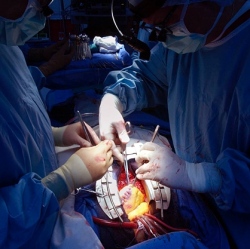
When exposed to a varying magnetic field, some conductive materials undergo a temperature increase of about 3-5 K over several minutes. This effect is called induction heating, and it occurs because small electric currents cause heating due to resistance.
Now in a new study, scientists have found that, under the same conditions, the temperature of a certain magnetic material increases by more than 20 K in less than a minute, and then abruptly stops and does not increase any further. The large, self-regulated heating power occurs at just the right temperature to potentially enable it to be used as a safe and effective form of hyperthermia treatment of cancer cells.
The researchers, led by Professor Kiyonori Suzuki at Monash University, Australia, and Professor Karl G. Sandeman at CUNY-Brooklyn College, US, and Imperial College London, UK, have published their paper on the extraordinary heating effect of the magnetic material in a recent issue of Applied Physics Letters.
The material, La-Fe-Si-H, is a well-known magnetocaloric material, meaning it heats up when exposed to a magnetic field. La-Fe-Si-H is also ferromagnetic at room temperature, so that its magnetic dipoles align with an applied magnetic field and remain aligned even when the magnetic field is removed.
This magnetic retention is an example of hysteresis, an effect in which the present state of a system is influenced by its past states. The scientists explain that the large heating power of La-Fe-Si-H is primarily due to the presence of thermomagnetic hysteresis near its Curie temperature.
However, the most significant property of the material is arguably not its large heating power, but its abrupt change in heating power, which is unmatched by any material of its kind. The large heating effect stops just short of the temperatures that could damage healthy cells.
As the scientists explain, the abrupt change in heating occurs because of the way that the material’s magnetic behavior changes as its temperature increases. The large hysteresis in La-Fe-Si-H occurs only up to a few degrees below its Curie temperature, which for this material is 319 K (46 °C, 115 °F). This temperature, which is about 21 K above room temperature, lies in the ideal temperature range required for effective yet safe hyperthermia therapy.
